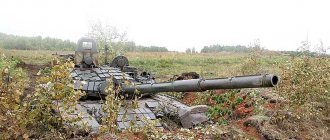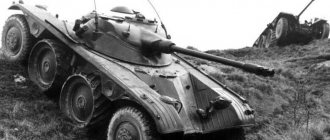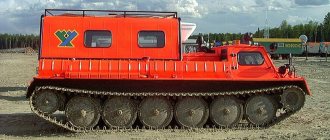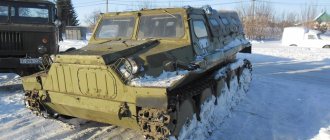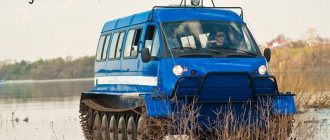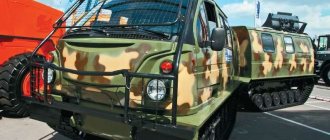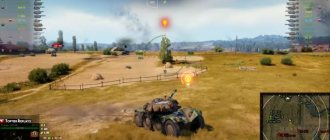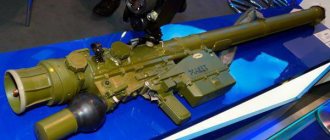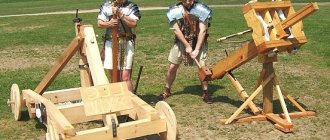Characteristics of GMZ-3
A country:USSRType:Tracked minelayerDate of issue:1980Length:9.3 mWidth:3.25 mHeight:2.7 mArmor, forehead:15 mmArmor, side:15 mmArmor, tower:15 mmCrew:3 personsEngine:1x V-59U or V-59UMS, 520 hpTravel range:500 kmMaximum speed:60 km/h (mining speed - up to 16 km/h)Weight:28 tonsWeapons:1x 7.62-mm PKT machine gun (1250 rounds), 6x 902V “Tucha” smoke grenade launchers. For the crew there is also 1x AKS-74 (150 rounds) and 10 F-1 grenades. The vehicle carries 208 mines of the TM-57, TM-62M, TM-62P3 types.
Kingisepp Machine-Building Plant
Overhaul of the V-59UMS for the needs of a large Ural enterprise. The company’s specialists carried out a major overhaul of the V-59UMS diesel engine.
According to the contract with a permanent partner - a large Ural machine-building enterprise, craftsmen from the Kingisepp Machine-Building Plant carried out a major overhaul of the V-59UMS diesel engine with the replacement of expired spare parts.
Engine V-59UMS before overhaul
The V-59 UMS diesel engine is supplied with an attached oil centrifuge, an oil filter, and a single set of spare parts. The engine is equipped with: electric generator;
· fine fuel filters;
· fuel priming pump;
· air start system.
| Technical characteristics of the V-59 UMS engine | |
| Engine type: four-stroke, V-shaped, 12-cylinder multi-fuel liquid-cooled diesel engine with inertia charging | |
| Mixing system | direct fuel injection |
| Engine power without resistance at inlet and outlet, kW (hp) | 382 (520) |
| Rotation speed, s-1 (rpm) | 33,3 (2000) |
| Torque reserve,% | 18 |
| Specific fuel consumption, g/kW*h (g/hp*h) | 231 (170) |
| Weight, kg | 950 |
| Specific power, kW/kg (hp/kg) | 0,4 (0,55) |
| Cylinder diameter, mm | 150,0 |
| Piston stroke in the cylinder with the main connecting rod, mm | 180,0 |
| Piston stroke in a cylinder with a trailing connecting rod, mm | 186,7 |
| Working volume, l | 38,88 |
| Minimum temperature for reliable engine starting without preheating, °C | +5°C |
| Permissible engine operating conditions: | |
| — ambient temperature | from -40°С to +50°С |
| - relative humidity | up to 98% at 20°C |
| - height above sea level | up to 3000 m |
| Flash sequence | uniform, after 60° crankshaft rotation |
| Degree of balance | complete dynamic balance |
Engine V-59UMS after major overhaul
Engine V-59UMS after major overhaul
Engine V-59UMS after major overhaul
www.kmz1.ru
History of the creation of the GMZ-3 minelayer
The tracked minelayer GMZ-3 (“Product 318”) is a modified model of the tracked minelayer GMZ “Product 118”. The purpose of the vehicle is the high-speed mechanized installation of anti-tank mines on the routes of movement of enemy mechanized formations. On one “charge”, the GMZ-3 minelayer can “sow” a strip 1-2 kilometers long with anti-tank mines within 10-20 minutes, depending on the type of mines used.
The development of GMZ-3 was carried out by the Transmash Central Design Bureau in Sverdlovsk under the leadership of General Designer Yuri Vasilyevich Tomashov in 1980 (lead designer L.A. Vaganov). Already in 1984, the GMZ-3 was put into service, and its developers were awarded the USSR State Prize.
General diagram of the GMZ-3 tracked minelayer
Even today, the machine has no analogues in the world - GMZ-3 allows not only to quickly and practically without human intervention place powerful minefields, but also automatically records the location of each individual mine on the map, and transmits the corresponding coordinates to the combat control center.
Compared to its predecessors, GMZ-3 does not have anti-nuclear and thermal smoke protection systems, but is equipped with a very advanced complex of navigation satellite and inertial equipment, which ensures automatic development of a course to a designated point from the anchor point, digital indexing of the vehicle’s coordinates, coordinates of the minefield nodes, coordinates of each mine.
Tracked minelayer GMZ-3, side view
2S3 is... What is 2S3?
2S3 History Dimensions Armor Armament Mobility Additional
| 2S3 "Acacia" | ||
| Classification | Self-propelled howitzer | |
| Combat weight, t | 27,5 | |
| Layout diagram | Classical | |
| Crew, people | 4 | |
| Manufacturer | ||
| Years of production | 2S3s 1967 to 19752S3Ms 1975 to 19872S3M1s 1987 to 19932S3M2s 2006 | |
| Years of use | since 1971 | |
| Number of issued, pcs. | 1797[1] | |
| Basic operators | ||
| Case length, mm | 6970 | |
| Length with gun forward, mm | 7765 | |
| Case width, mm | 3250 | |
| Height, mm | 3050 | |
| Base, mm | 4622 | |
| Track, mm | 2720 | |
| Ground clearance, mm | 450 | |
| Armor type | bulletproof | |
| Turret front, mm/deg. | 30 | |
| Cutting edge, mm/deg. | 30 | |
| Caliber and brand of gun | 152.4 mm 2A33 | |
| Gun type | rifled howitzer | |
| Barrel length, calibers | 27 | |
| Gun ammunition | 46 | |
| Angles VN, degrees. | -4..+60 | |
| Angles GN, degrees. | 360 | |
| Firing range, km | up to 20.5 | |
| Sights | PG-4, OP5-38, TKN-3A | |
| Machine guns | 1 x 7.62 mm PCT | |
| engine's type | V-59U | V-59U |
| Type: | diesel | |
| Volume: | 38,880 cm3 | |
| Maximum power: | 520 hp, at 2000 rpm | |
| Maximum torque: | 2059 Nm, at 1400 rpm | |
| Configuration: | V12 | |
| Cylinders: | 12 | |
| Fuel consumption combined cycle: | 180..220 l/100 km | |
| Fuel consumption on the highway: | 165 l/100 km | |
| Cylinder diameter: | 150 mm | |
| Piston stroke: | 180 mm | |
| Cooling: | liquid | |
| Clock (number of clock cycles): | 4 | |
| Recommended fuel: | multi-fuel | |
2S3 "Akatsia" (Object 303) - Soviet and Russian 152 mm self-propelled artillery unit.
Chief designer - G. S. Efimov[2], 152-mm guns 2A33 (D-22) - F. F. Petrov.
History of creation
The creation of a new generation self-propelled howitzer was preceded by a large number of scientific works and R&D. The experience gained during the Second World War with the use of self-propelled artillery guns SU-100, SU-152, ISU-152[3] was analyzed.
The task for the development of the 2S3 “Akatsiya” self-propelled howitzer was officially issued to the Sverdlovsk Machine-Building Department by resolution of the CPSU Central Committee and the Council of Ministers of the USSR No. 609-201 dated July 4, 1967[3].
When designing the howitzer, several chassis options were considered. Among them were: Object 118 (Tracked minelayer), Object 123 (chassis SPU 2P24 air defense system "Krug"), Object 124 (chassis SNR 1S32 air defense system "Krug"). The option of using the Object 432 medium tank as a chassis was also considered. After conducting research and analyzing the data obtained, it was recommended to use a chassis produced by the Sverdlovsk Machine-Building Plant as a base, which should go into service with artillery regiments of tank and motorized rifle divisions. Like other developments of that time (2S1 “Gvozdika”, 2S2 “Violet”, 2S5 “Gyacinth”), 2S3 was supposed to bridge the gap between the Soviet Union and NATO countries in the field of self-propelled artillery[3].
Prototypes
Based on “Object 124”[3]
- Weight, t: 25.842
- Crew: 4 people
- Armor type: Bulletproof
- Gun caliber and brand: 152.4 mm D-20
- Gun type: rifled howitzer
- Gun ammunition: 60 shots
- Machine guns: 1 x 7.62 mm PKT
- Engine type: Diesel V-59
- Engine power, hp: 520
- Highway speed, km/h: 70
- Cruising range on the highway, km: 500
Based on “Object 432”[3]
- Weight, t: 25
- Crew: 4 people
- Armor type: Bulletproof
- Gun caliber and brand: 152.4 mm D-20
- Gun type: rifled howitzer
- Gun ammunition: 60 shots
- Machine guns: 1 x 7.62 mm PKT
- Engine type: Diesel UTD-35
- Engine power, hp: 500
- Highway speed, km/h: 65
- Cruising range on the highway, km: 500
Mass production
2С3 "Acacia".
Museum of Technology, Arkhangelskoye, Moscow region. When designing the production model, the 2S3 design used parts and components of the experimental self-propelled installations “Object 105” (SU-100P), “Object 120” (SU-152 “Taran”; the Krug air defense missile system chassis and turret were used as the base commander was taken from “Object 118” (Tracked minelayer)[3].
Description of design
The 2S3 “Akatsiya” self-propelled howitzer is made according to the classic turret design: a welded body divided into three compartments: power (motor-transmission), control and combat compartments[3].
Armored hull and turret
The engine and transmission compartment is located in the front of the chassis body on the right. It houses the engine, powertrain systems and transmission[3].
The fighting compartment is located in the rear part of the self-propelled gun, which is formed from a turret with a floor and a rear part of the hull with equipment. At the bottom of the housing there is a rotating floor platform, which rests on five rollers and is mounted on a ball chase. The loader's seat is located to the right of the howitzer, and the gunner's seat is located to the left. The commander is behind the gunner[3].
The ammunition set is placed in two mechanized ammunition racks. For firing with ammunition supplied from the ground, there is a special hatch in the rear of the hull[3].
Armament
The 2A33 (D-22) howitzer was used as a weapon for the 2S3 self-propelled howitzer. The development was carried out by OKB-9; the 152-mm D-20 gun-howitzer was used as a base; it was manufactured in Perm at the Motovilikha Plant. A gun with a vertical wedge breech, a two-chamber muzzle brake and an ejector is placed in a rotating closed armored turret[3].
The 2A33 gun is equipped with an electromechanical rammer for the projectile and cartridge case, as well as a tray to catch the spent cartridge case, to facilitate the work of the loader. Shooting is only possible from a standing position[3].
On the left on the roof of the tower is the commander's cupola, with a PKT machine gun installed[3].
Currently, adjustable “Centimeter” projectiles have been developed for 2S3 to destroy armored vehicles in places where launchers are concentrated, long-term defensive structures, bridges and crossings. In addition, the use of Krasnopol guided missiles is provided [3].
| Ammunition nomenclature[4][5] | |||||
| Shot index | Projectile index | Charge index | Shot weight, kg | Explosive mass, kg | Maximum firing range, km |
| Armor-piercing | |||||
| 3VBP2 | 53-BP-540 | 4Zh6 | 27,67 | 2 | |
| 3VBP5 | |||||
| Armor-piercing | |||||
| 53-VBR-546[sn 1] | 53-BR-540 | 54-ZhD-545B | 48,8 | 0,66 | 1 |
| 53-VBR-546B[sn 2] | 53-BP-540B | 54-ZhD-545B | 46,5 | 0,48 | 1 |
| Concrete | |||||
| 3VG1 | |||||
| Fragmentation | |||||
| 3VO13 | 3-O-13 | 54-ZhN-546 | 41,4 | 0,23 | 14,5 |
| 3VO14 | 3-O-13 | 54-Zh-546U | 41,4 | 0,23 | 11 |
| 3VO29 | 3-O-23 | 54-ZhN-546 | 42,8 | 0,042 | |
| 3VO30 | 3-O-23 | 54-Zh-546U | 42,8 | 0,042 | |
| High-explosive fragmentation | |||||
| 53-VOF-546 | 53-OF-540(Zh) | 54-ZhN-546/4Zh38 | 43,56 | 5,9—6,25 | 15,92 |
| 53-VOF-546 | 53-OF-540(Zh) | 54-Zh-546U | 43,56 | ||
| 3VOF27 | 3OF22 | 54-ZhN-546 | 43,33 | ||
| 3VOF32(-1) | 3OF22 | 54-ZhN-546/4Zh38 | 43,56 | 6,8 | 17,4 |
| 3VOF33(-1) | 3OF22 | 54-Zh-546U | 43,56 | 6,8 | 13,4 |
| 3VOF33(-1) | 3OF22 | 54-Zh-546U | 43,56 | 6,8 | 13,4 |
| 3VOF58(-1) | 3OF45 | 54-ZhN-546/4Zh38 | 43,56 | 7,65 | |
| 3VOF73(-1) | 3OF45 | 54-Zh-546U | 43,56 | 7,65 | |
| 3VOF97 (Active-reactive) | 3OF64 | 54-ZhN-546 | 43,56 | 7,8 | 19,4 |
| 3VOF98 (Active-reactive) | 3OF64 | 54-Zh-546U | 43,56 | 7,8 | 14,2 |
| Managed | |||||
| 3VOF63 | 3OF38 | 54-ZhN-546 | 49,5 | 8.5 (TNT equivalent) | 12 |
| 3VOF64 | 3OF39 | 50 | 6,3 | 20 | |
| 3VOF64M | 3OF39M | 43 | 5,5 | 17 | |
| 3VOF66 | 3OF38 | 54-Zh-546U | 49,5 | 8.5 (TNT equivalent) | 12 |
| "Centimeter-M" | 3OF75 | 48 | 10 (TNT equivalent) | 18 | |
| Shrapnel | |||||
| 3VSh2 | 3Ш2 | 54-ZhN-546/4Zh38 | 43,56 | ||
| 3VSh5 | 3Ш2 | 54-Zh-546U | 43,56 | ||
| HF/VHF jammer | |||||
| 3VRB36 | 3RB30 | 54-Zh-546U | 43,56 | — | 13,5 |
| 3VRB37 | 3RB30 | 54-ZhN-546 | 43,56 | — | 18 |
| Lighting | |||||
| 3ВС16 | 3С6(-1) | 54-ZhN-546/4Zh38 | 39,7 | — | |
| 3ВС17 | 3С6(-1) | 54-Zh-546U | 39,7 | — | |
| 3ВС22 | 3S1 | 54-ZhN-546/4Zh38 | 40,2 | — | |
| 3ВС23 | 3S1 | 54-Zh-546U | 40,2 | — | |
| Chemical | |||||
| 3X3 | |||||
| Nuclear | |||||
| V3VB3[6][7] | 3VB3 | 1 kt (TNT equivalent) | 17,4 | ||
Engine and transmission
The 2C3 has a V-shaped 12-cylinder four-stroke liquid-cooled supercharged diesel engine. The transmission is mechanical, double-flow, with a planetary rotation mechanism. The suspension is individual, torsion bar with telescopic hydraulic shock absorbers[3].
Modifications
2S3M
In the early 70s, work was carried out at the Transmash Central Design Bureau to modernize a self-propelled howitzer. The upgraded version was assigned the index 2С3М[3].
The changes affected mechanized laying. The 2S3M is equipped with one mechanized drum-type stowage, instead of two on the basic version, which made it possible to increase the carried ammunition from 40 to 46 rounds. In addition, the configuration and location of the hatches in the rear of the hull and turret were changed. The radio communication antenna was moved to the roof of the tower. The 2S3M was launched into mass production in 1975[3].
Characteristics[3]
- Weight, t: 27.5
- Years of production: from 1975 to 1987
- Length, mm: 6970
- Length with gun, mm: 7760
- Width, mm: 3250
- Height, mm: 2530
- Ground clearance, mm: 450
- Tower forehead, mm: 30
- Chopping forehead, mm: 30
- Gun caliber and brand: 152.4 mm 2A33
- Gun type: rifled howitzer
- Barrel length, calibers: 28
- Gun ammunition: 46 shots
- BH angles: -4..+65
- GN angles: 360
- Firing range, km: 4.2..20.5
- Rate of fire, rds/min: 1.25..3.5[8]
- Sights: PG-4, OP5-38
- Machine guns: 1 x 7.62 mm PKT
- Engine type: V-59-4
- Engine power, hp: 520
- Highway speed, km/h: 63
- Cruising range on the highway, km: 500
- Specific power, hp/t: 19
- Specific ground pressure, kg/sq.cm: 0.6
- Climbability, degrees: 30
- Wall to be overcome, m: 0.7
- Ditch to be overcome, m: 2.5..2.55
- Fordability, m: 1
2S3M1
A further modernization of 2S3, after 2S3M, became 2S3M1. Unlike the 2S3M, this modification is equipped with a 1P5 sight and 1V116 communications equipment. In addition, equipment was installed to receive command information from the vehicle of the senior battery officer (MSOB). This modification has been put into production since 1987[3].
2S3M2
The latest deep modernization of the 2S3 was designated 2S3M2. The changes affected the artillery part of the self-propelled howitzer. The 2A33 howitzer was replaced with a more powerful 152.4-mm howitzer 2A33M (in the export version, replacement with a 155-mm M-385 howitzer is provided), which gave an increased firing range compared to previous versions. In addition, an automated guidance and fire control system ASUNO has been added. The security of the vehicle has been improved thanks to the installation of the 902B system for setting up smoke screens[3].
Characteristics of 2S3M2[3]
- Weight, t: 28
- Length, mm: 6970
- Length with gun, mm: 9170
- Width, mm: 3250
- Height, mm: 2530
- Ground clearance, mm: 450
- Tower forehead, mm: 30
- Chopping forehead, mm: 30
- Gun caliber and brand: 152.4 mm 2A33M
- Gun type: rifled howitzer
- Barrel length, calibers: 39
- Gun ammunition: 45 shots
- BH angles: -4..+65
- GN angles: 360
- Firing range, km: up to 25.1
- Sights: PG-4, OP5-38
- Machine guns: 1 x 7.62 mm PKT
- Engine type: V-59-4
- Engine power, hp: 520
- Highway speed, km/h: 63
- Cruising range on the highway, km: 500
- Specific power, hp/t: 19
- Specific ground pressure, kg/sq.cm: 0.6
- Climbability, degrees: 30
- Wall to be overcome, m: 0.7
- Ditch to be overcome, m: 2.5
- Fordability, m: 1
Characteristics of 2S3M2-155[3]
- Weight, t: 28
- Length, mm: 6970
- Length with gun, mm: 9170
- Width, mm: 3250
- Height, mm: 2530
- Ground clearance, mm: 450
- Tower forehead, mm: 30
- Chopping forehead, mm: 30
- Gun caliber and brand: 155 mm M-385
- Gun type: rifled howitzer
- Barrel length, calibers: 39
- Gun ammunition: 45 shots
- BH angles: -4..+65
- GN angles: 360
- Firing range, km: up to 30
- Sights: PG-4, OP5-38
- Machine guns: 1 x 7.62 mm PKT
- Engine type: V-59-4
- Engine power, hp: 520
- Highway speed, km/h: 63
- Cruising range on the highway, km: 500
- Specific power, hp/t: 19
- Specific ground pressure, kg/sq.cm: 0.6
- Climbability, degrees: 30
- Wall to be overcome, m: 0.7
- Ditch to be overcome, m: 2.5
- Fordability, m: 1
Operators
- Azerbaijan - from 3 to 6 2S3, as of 2010[9], a total of 40 2S3 units were delivered[10], an additional 16 2S3 units were supplied from Ukraine in the period from 2009 to 2010[11]
- Angola - 4 2S3, as of 2010[12], a total of 48 2S3 units delivered[10]
- Armenia - 28 2С3, as of 2010[13]
- Belarus - 163 2S3, as of 2010[14], a total of 166 2S3 units delivered[10]
- Hungary - 5 2С3 according to JSC Motovilikha Plants[10]
- Vietnam - 30 2С3, as of 2010[15]
- GDR - 95 2S3 units delivered from the USSR between 1979 and 1985[11]
- DR Congo - 12 2S3 units delivered from Ukraine in 2010[11]
- Georgia - 1 2С3, as of 2010[16], 13 units according to other data[17], according to Gazeta. Ru" 8 units 2S3M, as of 2008[18]
- Iraq - withdrawn from service since 2006[19]
- Kazakhstan - 120 2С3, as of 2010[20]
- Cuba - 40 units 2S1 and 2S3 as of 2010[21]
- Libya - 60 2С3, as of 2010[22], 36 units delivered according to Motovilikha Plants OJSC[10]
- Russia:
Service and combat use
Organizational structure
Russia
- military unit No. 02511. 138th Separate Guards Motorized Rifle Krasnoselskaya Order of Lenin Red Banner Brigade (138th Omsbr): 36 2S3M units as of 2009[31].
- military unit No. 06705. 36th Separate Guards Motorized Rifle Lozovskaya Red Banner Brigade (36th Omsbr): 36 2S3M units as of 2009[31].
- military unit No. 08275. 200th Separate Motorized Rifle Pechenga Order of Kutuzov Brigade (200th Motorized Rifle Brigade): 18 2S3M units as of 2009[31].
- military unit No. 09332. 7 Krasnodar Red Banner Orders of Kutuzov and Red Star military base (7 military base): 24 2S3M units as of 2009[31].
- military unit No. 16544. 8th Separate Guards Motorized Rifle Chertkovskaya twice Order of Lenin Red Banner Orders of Suvorov, Kutuzov and Bogdan Khmelnitsky Mountain Brigade named after Marshal of Armored Forces Katukov M.E. (8 omsbr (g)): 36 units of 2S3M as of 2009[31].
- military unit No. 20634. 19th separate motorized rifle Voronezh-Shumlinskaya Red Banner Order of Suvorov and Red Banner of Labor Brigade (19th Omsbr): 36 units 2S19/2S3M as of 2009[32].
- military unit No. 21005. 74th Separate Guards Motorized Rifle Zvenigorod-Berlin Order of Suvorov Brigade (74th Omsbr): 36 2S3M units as of 2009[31].
- military unit No. 21720. 38th Separate Guards Motorized Rifle Vitebsk Order of Lenin Red Banner Order of Suvorov Brigade (38th Omsbr): 36 2S3M units as of 2009[31].
- military unit No. 22316. 32 separate motorized rifle Leningrad-Pavlovsk Red Banner Brigade (32 Omsbr): 36 2S3M units as of 2009[31].
- military unit No. 27777. 18th Separate Guards Motorized Rifle Evpatoria Red Banner Brigade (18th Omsbr): 36 2S3M units as of 2009[31].
- military unit No. 29760. 25th Separate Guards Motorized Rifle Red Banner Brigade (25th Omsbr): 36 2S3M units as of 2009[31].
- military unit No. 30615. 247 Red Banner base for storage and repair of weapons and equipment (247 BKhiRVT): 18 2S3M units as of 2009[31].
- military unit No. 46108. 5th Separate Guards Tank Tatsinskaya Red Banner Order of Suvorov Brigade (5th brigade): 18 2S3M units as of 2009[31].
- military unit No. 54046. 9th separate motorized rifle Vistula Red Banner Order of Suvorov and Kutuzov Brigade (9th Omsbr): 36 2S3M units as of 2009[31].
- military unit No. 54096. 6th separate tank Red Banner Order of Kutuzov brigade (6th brigade): 18 2S3M units as of 2009[31].
- military unit No. 65349. 23rd Separate Guards Motorized Rifle Petrakuvskaya Twice Red Banner Orders of Suvorov, Kutuzov and Bogdan Khmelnitsky Brigade (23rd Omsbr): 36 2S3M units as of 2009[31].
- military unit No. 65384. 17th Separate Guards Motorized Rifle Order of Suvorov and Alexander Nevsky Brigade (17th Omsbr): 36 2S3M units as of 2009[31].
- military unit No. 66431. 4th Guards Vapnyarsko-Berlin Red Banner Orders of Suvorov and Kutuzov military base (4 military base): 18 2S3M units as of 2009[31].
- military unit No. 69670. 20th Separate Guards Motorized Rifle Carpathian-Berlin Red Banner Order of Suvorov Brigade (20th Omsbr): 18 2S3M units as of 2009[31].
- military unit No. 69671. 136th Separate Guards Motorized Rifle Uman-Berlin Red Banner Order of Suvorov, Kutuzov and Bogdan Khmelnitsky Brigade (136th Omsbr): 36 2S3M units as of 2009[31].
- military unit No. 69672. 205 separate motorized rifle Cossack brigade (205 omsbr): 36 2S3M units as of 2009[31].
- military unit No. 89547. 7th Separate Guards Tank Red Banner Orders of Suvorov, Kutuzov and Alexander Nevsky Orenburg Cossack Brigade (7th brigade): 18 2S3M units as of 2009[31].
- 104 Base for storage and repair of weapons and equipment (85 separate motorized rifle brigade): 36 2S3M units as of 2009[31].
- 201 Gatchina twice Red Banner military base (201 base): 36 2S3M units as of 2009[31].
- 225 Base for storage and repair of weapons and equipment (29 Omsbr): 36 2S3M units as of 2009[31].
- 230 Storage and repair base for weapons and equipment (88 separate motorized rifle brigade): 36 2S3M units as of 2009[31].
- 240 Base for storage and repair of weapons and equipment (90 separate motorized rifle brigade): 36 2S3M units as of 2009[31].
- Perm PSH: 72 2S3 units as of 2000[31].
- Perm 39 Arsenal (39 Ars-V): 19 2S3 units as of 2000[31].
Combat use
- Afghan War (1979-1989)[3]
- Civil war in Tajikistan
- First Chechen War[3]
- Second Chechen War[3]
- Armed conflict in South Ossetia (2008)[33]
Notes
Footnotes
- ↑ It must be taken into account that the 53-BR-540 projectile is not included in the standard 2S3 ammunition
- ↑ It must be taken into account that the 53-BR-540R projectile is not included in the standard 2S3 ammunition
Literature
Links
Reserve artillery of the Supreme High Command Anti-aircraft artillery Naval artillery Naval artillery Coastal artillery
dic.academic.ru
Products
Today OJSC Guryev Metallurgical Plant (TIN 4204000253) produces the following types of metallurgical products:
- Steel balls of various types.
- Round steel bars.
- Round bars intended for drum-type mills.
- Steel square bars.
- Equal-flange steel angle.
- Steel channel.
- Asymmetrical striped bulb for shipbuilding.
- Special lightweight profile for conveyors.
- Special profile for braids.
- Profile for wagons.
Repurposing
With the development of the regional economy, the emergence of gold mining in the Salair region and the development of coal deposits, the chief designer of the plant, P. M. Zalesov, proposed building a blast furnace and an iron-making forge in addition to the silver smelting equipment. In 1826, the first blast furnace was launched, and soon an iron-making factory was built at the plant. Since that time, the Guryev Metallurgical Plant has been changing its profile.
Gradually, iron production became the main one. At the beginning of 1840, the iron smelting department finally replaced the silver smelting department, and in 1844 the enterprise began to function as a ferrous metallurgy plant. The products of Guryev metallurgists made from damask steel were presented at the international exhibition of 1851, held in London, where they were awarded silver medals.
Great Patriotic War and post-war development
Metallurgists at GMZ mastered the rolling of shaped profiles during the war. The company was the only supplier in the USSR of thin-walled complex rolled profiles for the aircraft industry. After the end of the Second World War, the plant produced alloy and open-hearth steel, rolled steel, spare parts for agricultural machinery, building bricks, various metal products, structures and equipment, which were much needed for the restoration of the economy.
Production in the 60s became unprofitable due to unequal competition with KMK. In 1970, a large-scale process of reconstruction of technological capacities began. By mechanizing the most labor-intensive operations, the administration was able to restore profitability and regain customer confidence.
Economic locomotive
The Guryev Metallurgical Plant stood at the origins of metallurgy and mechanical engineering in Western Siberia. In 1860, a mechanical factory opened within the walls of the enterprise (which became the first beyond the Urals). It included five workshops: assembly, forging, boiler equipment, foundry, model. The newly formed factory specialized in the assembly of steam engines, tools and tools for mining. The Guryevsky plant was the only ferrous metallurgy production east of the Ob. It supplied products to agriculture and industry throughout the region.
Beginning of the Soviet era
After the revolution in the 20s, a radical reconstruction of the enterprise was carried out. In 1922, a blast furnace was put into operation and the first cast iron smelted from coal was produced. Since 1924, open-hearth steel has been smelted, and a year later the plant began producing rolled products. Thus, GMZ became the first production facility beyond the Urals with a full metallurgical cycle.
In 1929, it produced 6221 tons of cast iron, 8629 tons of iron and steel ingots, 7940 tons of rolled products, 7464 tons of iron castings, 3188 tons of refractories. The enterprise produced valuable and irreplaceable products for new industrial construction and existing enterprises throughout Siberia. First of all, these are rails, rolled products, angle and reinforcing iron, castings, bolts, etc. During the period from 1925 to 1940, the production of main types of products at the Guryev Metallurgical Plant increased significantly: steel from 1168 to 35045 tons, rolled products from 1299 to 48643 tons, refractories from 3000 to 10156 tons, castings from 784 to 6605 tons.

